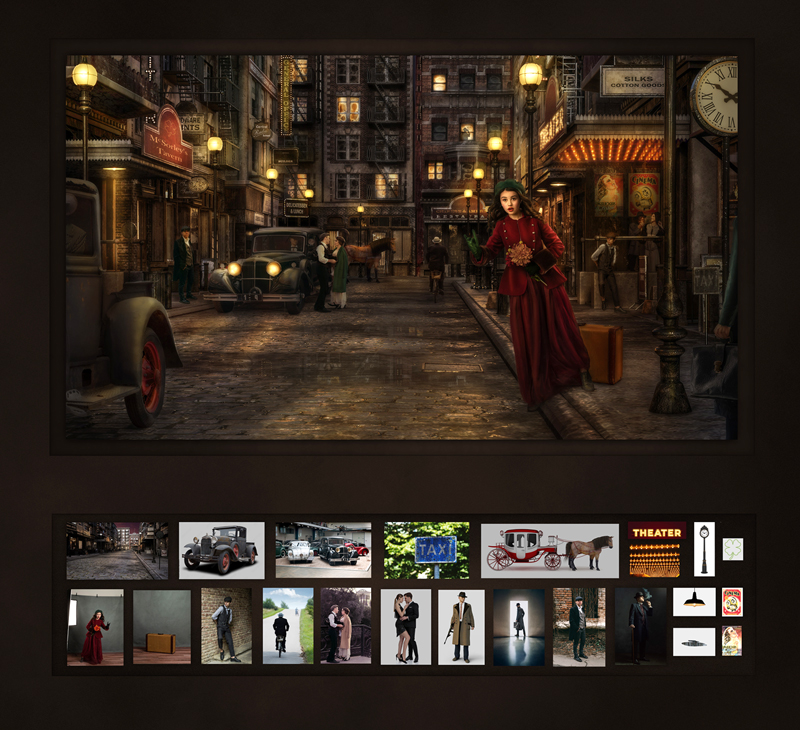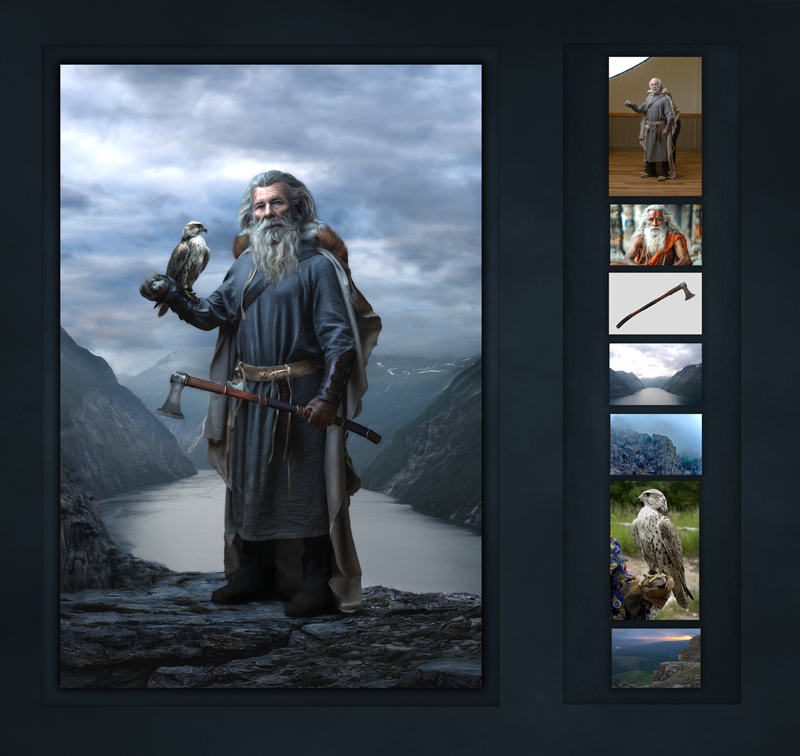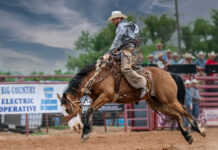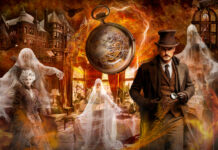A Guide to Digital Storytelling
By Amber Damour
Texas School Instructor
Photography is often about capturing reality, but sometimes I like to break that mold. Fine art composites allow me take elements from different places and times and create something new, something that exists only in my imagination. These pieces are more than just photos. They’re stories, feelings, and experiences all tethered into a single image. Creating a fine art composite is an artistic journey, and while there are plenty of technical skills involved, the most important thing is having a vision and being willing to bring it to life.
Here’s how I approach creating fine art composites, from the spark of an idea to the final image.
For me, every fine art composite starts with an idea. This is the heart of the piece. I usually think about what story I want to tell. It might be a feeling, an emotion, or a moment that I want to capture. Sometimes, the idea is simple – like wanting to evoke nostalgia or create something whimsical. Other times, it’s more intricate and complex, and the story has layers I want to express.
Once I have the idea, I’ll often sketch it out. My sketches are more like rough maps to help me visualize how the different pieces will come together. It’s a way to get a feel for how I want the elements of the scene to interact with each other, what the layout might look like, and which direction the light will come from. It doesn’t have to be perfect; it just needs to give me a solid starting point.
Next comes the background. The background is where everything starts. It’s the foundation of the image. For me, the background sets the tone and atmosphere for the entire composite. If I’m going for a vintage, nostalgic feel, I might choose an old diner or a soft, foggy landscape. The background often dictates the lighting, color scheme, and mood for the whole piece, and I always make sure that the elements I add later will align with it.
Sometimes, though, I’ll start with the subject matter and choose the background to complement that. If I’ve already decided on a subject, like a particular person or object, I think about what background will support or contrast that subject in a way that enhances the overall story. This can lead to more creative compositions because the subject ends up guiding the scene instead of the background dictating everything.
Once the background is chosen, I spend some time thinking about lighting. It’s critical that the lighting in the background matches the lighting in the rest of the scene, so all the elements blend seamlessly together. I also make sure the perspective lines up. For example, if the background has a specific vanishing point or angle, I make sure that the figures I photograph will fit into that same space. The goal is for everything to look like it belongs together, even though it might have come from entirely different places.
After the groundwork is laid, it’s time to gather the pieces that will make up the composite. When possible, I prefer to photograph the elements myself, but I also use stock images or create elements with AI generative tools if needed. It’s all about control – I want to make sure I can manage the lighting and perspective so that everything fits perfectly into the background.

When I photograph the elements, I try to match the lighting as closely as possible to what’s in the background. If the background is softly lit, I try to create the same kind of light for the subjects I’m photographing. I also pay attention to details like reflections and textures. These might seem like small things, but they’re incredibly important for making the final image feel natural.
Once I have all the elements, I open the background in Photoshop and start layering everything else on top. This is where the magic happens. The background serves as my canvas, and I start adding layers with each new piece: people, objects, textures, and so on. I use masks to blend these layers seamlessly. Masks let me remove parts of a layer and blend them into the layer beneath without permanently altering the image. It’s the best way to make everything feel unified, as if it all belongs in the same scene.
One of the most important parts of this stage is matching the color palette. The elements I add to the scene have to align with the colors of the background. I’ll tweak the hues and saturation to make sure everything fits together. Sometimes it’s subtle, just a few tweaks here and there. But it makes a big difference.
It’s also critical to match the light direction and quality. If the background light is coming from the left, then the shadows on the elements I’m adding need to reflect that.
Now comes the fun part, adding shadows and highlights. These are the things that really give depth and dimension to the composite. Without them, the elements can feel flat, and the scene will lose its realism. I pay a lot of attention to the direction of light. If the background has a particular kind of lighting, I replicate that on the subjects, adjusting shadows and highlights accordingly. It’s all about making sure everything fits together.

Subtle details, like reflections on the floor or highlights on edges, are key to creating a believable composite. It’s these little touches that help the pieces feel like they belong in the same world, even if they were captured at different times and places.
Once all the technical details are in place, I step back and think about the story. Does the image tell the story I had in mind? Does it evoke the right feeling? A great fine art composite has to feel like it’s more than just a photo. It has to make the viewer want to stay and look closer, to dig into the layers of the story I’m trying to tell.
At this point, I usually go through the image a few times, adjusting things like composition or adding or removing elements until the image feels right. I’ll add some extra texture or lighting effects here and there if I feel it will enhance the piece. It’s these final touches that bring the story to life.
Creating a fine art composite is never without its challenges. Getting the lighting, color, and perspective just right can be tricky. Sometimes, I’ll spend hours working on a composite only to realize that one small detail is off, which can throw everything else out of balance. But it’s all part of the process. I’ve learned that sometimes the best thing to do is step away from the project for a bit and return to it with fresh eyes.
One of the most rewarding things about working on composites is seeing how they evolve. It’s like a puzzle – sometimes it takes a while to fit all the pieces together, but when it finally clicks, it’s incredibly satisfying.
The final stage in creating a fine art composite is printing. I’ve always believed that a printed image brings something extra to the experience. When I see the work on paper or canvas, it feels more real, more substantial. The texture of the paper or canvas adds another layer to the image, giving it a new depth and presence.

It’s also a reminder of the journey that went into creating it, from the initial idea to the final print.
Fine art composites are a way for me to bring my imagination to life. They let me create whole worlds and tell stories that wouldn’t be possible with a single shot. It takes time, patience, and a willingness to experiment, but the payoff is worth it. Every composite is a new opportunity to tell a different story, explore new ideas, and learn new techniques.
What I love most about fine art composites is that they are more than just images – they’re an invitation to dive into a world I’ve created. They allow me to connect with others in a way that’s both personal and universal. So, I encourage you to try it out – let your imagination run wild and create something that tells your own story. After all, the possibilities are endless.
 Amber Damour is portrait photographer and composite artist based in Dallas, Texas, specializing in creating storytelling imagery for children, families, maternity, and seniors. She will be teaching a class on “Unveiling Creativity – Transforming Ideas Into Storytelling Imagery” at the 2025 Texas School of Professional Photography. Learn more about Amber and her work at www.AmberDamour.com.
Amber Damour is portrait photographer and composite artist based in Dallas, Texas, specializing in creating storytelling imagery for children, families, maternity, and seniors. She will be teaching a class on “Unveiling Creativity – Transforming Ideas Into Storytelling Imagery” at the 2025 Texas School of Professional Photography. Learn more about Amber and her work at www.AmberDamour.com.











